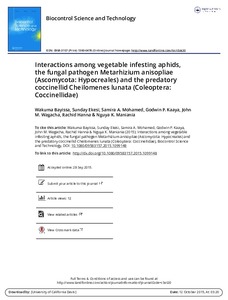| dc.contributor.author | Bayissa, W. |
| dc.contributor.author | Ekesi, S. |
| dc.contributor.author | Mohamed, S. |
| dc.contributor.author | Kaaya, G.P. |
| dc.contributor.author | Wagacha, M. |
| dc.contributor.author | Hanna, R. |
| dc.contributor.author | Maniania, N.K. |
| dc.date.accessioned | 2019-12-04T11:03:36Z |
| dc.date.available | 2019-12-04T11:03:36Z |
| dc.date.issued | 2016 |
| dc.identifier.citation | Bayissa, W., Ekesi, S., Mohamed, S.A., Kaaya, G.P., Wagacha, J.M., Hanna, R. & Maniania, N.K. 2016. Interactions among vegetable-infesting aphids, the fungal pathogen Metarhizium anisopliae (Ascomycota: Hypocreales) and the predatory coccinellid Cheilomenes lunata (Coleoptera: Coccinellidae). Biocontrol Science and Technology, 26(2), 274-290. |
| dc.identifier.issn | 0958-3157 |
| dc.identifier.uri | https://hdl.handle.net/20.500.12478/1162 |
| dc.description | Published online: 06 Nov 2015 |
| dc.description.abstract | Entomopathogenic fungi are among biocontrol agents being considered for the control of aphids on a variety of crops. Predatory coccinellids, although generalist, are also among important natural enemies that must be conserved for aphid management. Laboratory studies were carried out to investigate the interaction between three vegetable-infesting aphids, Metarhizium anisopliae isolate ICIPE 62 and the coccinellid predator Cheilomenes lunata. At a concentration of 1 × 108 conidial ml–1, the fungus was found to cause mortality of 7.5% to C. lunata, compared to 2.5% mortality in the control at 10 days post-treatment. Female adult C. lunata to which fungus-infected aphids were offered as prey never accepted them as food source in non-choice bioassays. However, live and dead non-infected aphids were fed upon. In choice bioassay, a total of 1–3 out of 24 infected non-sporulating aphids per species (average of 0.1–0.4 aphids per arena) were consumed by 48 h-starved C. lunata within a period of 60 min, but avoided sporulating cadavers. Foraging adult C. lunata enhanced the spread of conidia of M. anisopliae from infected cadavers to fourth instars Aphis gossypii feeding on okra (0.8–15.0% mortality), Brevicoryne brassicae (3.3–15.0% mortality) and Lipaphis pseudobrassicae (0.8–14.2% mortality) on kale plants. Results of this study demonstrate compatibility between M. anisopliae and C. lunata, and could provide a sustainable strategy for effective management of aphids on crucifers and okra cropping systems. |
| dc.format.extent | 274-290 |
| dc.language.iso | en |
| dc.subject | Aphids |
| dc.subject | Starvation |
| dc.subject | Spread |
| dc.title | Interactions among vegetable-infesting aphids, the fungal pathogen Metarhizium anisopliae (Ascomycota: Hypocreales) and the predatory coccinellid Cheilomenes lunata (Coleoptera: Coccinellidae) |
| dc.type | Journal Article |
| dc.description.version | Peer Review |
| cg.contributor.crp | Agriculture for Nutrition and Health |
| cg.contributor.affiliation | International Centre of Insect Physiology and Ecology |
| cg.contributor.affiliation | University of Nairobi |
| cg.contributor.affiliation | International Institute of Tropical Agriculture |
| cg.coverage.region | Africa |
| cg.coverage.region | East Africa |
| cg.coverage.country | Kenya |
| cg.identifier.url | https://dx.doi.org/10.1080/09583157.2015.1099148 |
| cg.isijournal | ISI Journal |
| cg.authorship.types | CGIAR and developing country institute |
| cg.iitasubject | Disease Control |
| cg.journal | Biocontrol Science and Technology |
| cg.howpublished | Formally Published |
| cg.accessibilitystatus | Limited Access |
| local.dspaceid | 78237 |
| cg.targetaudience | Scientists |
| cg.identifier.doi | https://dx.doi.org/10.1080/09583157.2015.1099148 |

